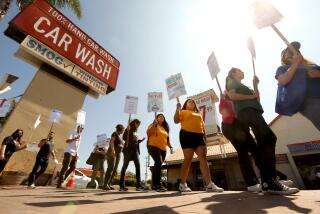Buses and Leadership in Short Supply
- Share via
Elvira Quintana stepped gingerly off a bus at Olympic Boulevard and Lorena Street on Thursday and headed west, carefully, slowly, six months pregnant.
The sun had burned off the early morning chill, and perspiration beaded up on Quintana’s forehead as she schlepped past modest apartments in a neighborhood hit hard by the MTA strike.
When I offered the 35-year-old Covina resident a ride, she smiled and said she was almost at her destination -- the L.A. County social services office on Olympic near Soto Street.
It was a trip that had begun the night before, thanks to the strike, and Quintana carried her belongings in a backpack. Wednesday night, she bused in from Covina to stay with her sister at 6th and Indiana, so she could cover the rest of the distance in just under an hour on Thursday and take care of some Medi-Cal paperwork.
Quintana said that with MTA out of commission during the three-week strike, she has had to combine suburban bus lines with rides from family and friends. And lots of walking.
At times during the strike, she said, she has walked as much as two miles. When I spotted her, she was covering a stretch just under three-quarters of a mile, and panting a bit.
“I’ve had to do this two or three times a week during the strike,” said Quintana, who was in the middle of a move from East L.A. to Covina when the strike began and is still lugging belongings and transferring personal business.
Quintana said she’s too busy to study the strike issues and figure out who to be mad at.
“I guess they gotta do what they gotta do,” she said, flashing her broad, warm smile again.
If there’s a city in the world where a public transit strike could go on forever and ever without much hand-wringing or hostility, it’s this one. L.A. Mayor Jim Hahn is nearly invisible, as usual, and that great sucking sound you hear is the countywide leadership vacuum. But it’s not like there’s a deafening public cry for a settlement.
In a region this sprawling and divided, 98% of us don’t ride the bus or have much contact with those who do. We’re ensconced in our cars and our separate worlds and the strike means nothing. Sure, traffic is insane, but it’s always nuts.
So unless you’re waiting on the nanny or the housekeeper, or you’re running a business that relies on employees or customers to arrive by bus or train, or you’re a student whose parents don’t have a car, this strike is little more than a nuisance, and a distant one at that.
Until you see Elvira Quintana walk down the street six months pregnant.
“It’s good for me, I guess, “ said Quintana, who is on maternity leave from her clerical job at a law office. “But when I have to do a lot of walking, my back aches at the end of the day.”
When she completed her business inside, I offered to drive Quintana back to Covina. But she was waiting on her boyfriend, Jose, a laid-off truck driver who now hustles day jobs and gets around the same way she does, thanks to the strike. Jose had business of his own at the social services office.
I told Quintana she smiles a lot for a pregnant woman with no car in the middle of a transit strike. She said she had made some mistakes and went through a rough patch, but had faith that things were turning her way. “Adversity makes you stronger,” she said.
She and Jose are going to be married, Quintana said, and one day they’ll do well enough to have a car and a place of their own. When Jose arrived, he took her hand and kissed her and, as they disappeared into the social services building, she turned my way and smiled once more.
More to Read
Sign up for Essential California
The most important California stories and recommendations in your inbox every morning.
You may occasionally receive promotional content from the Los Angeles Times.














